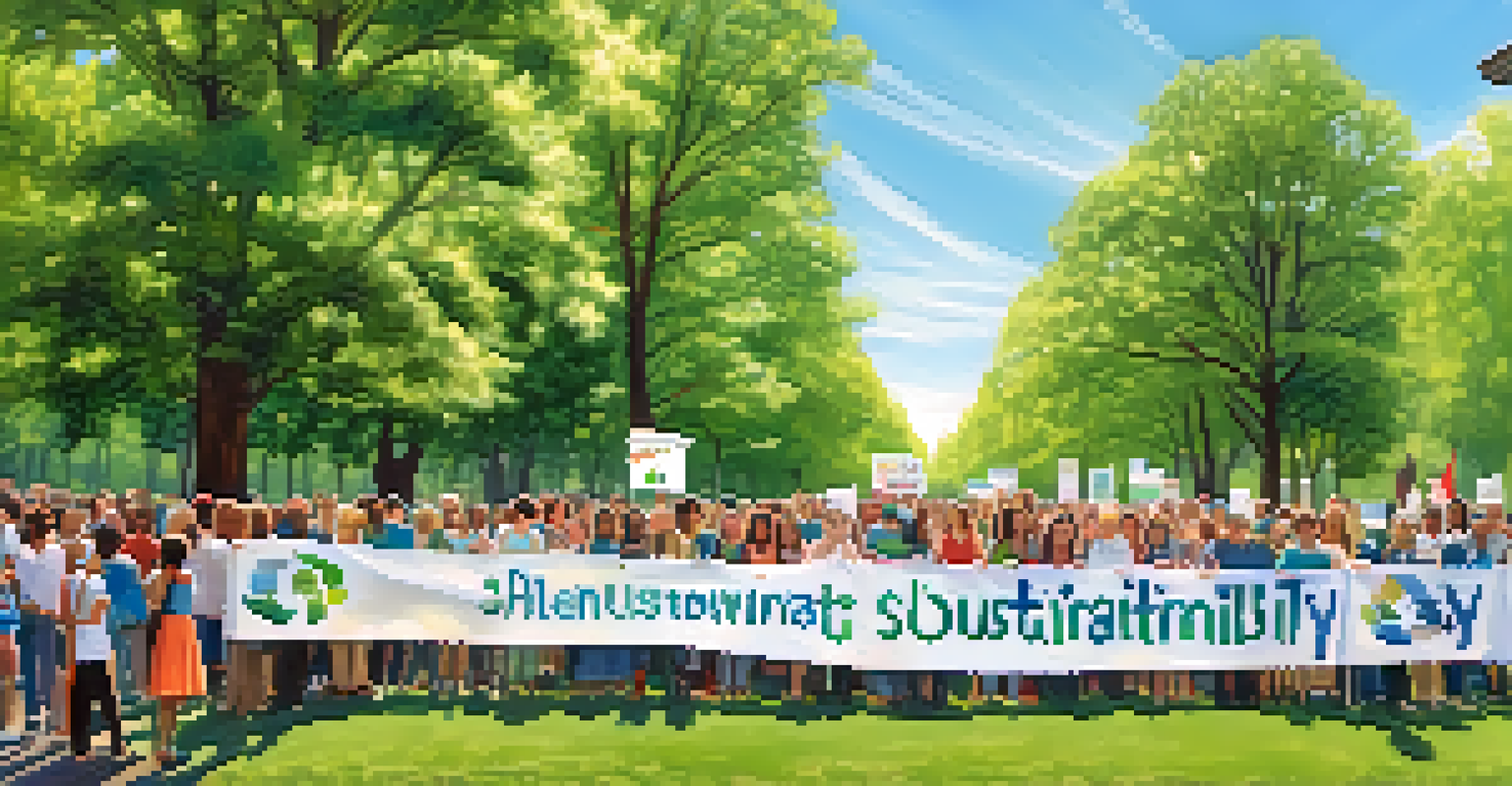The Benefits of Collaborative Sustainability Projects

Collaboration: The Heart of Sustainable Initiatives
Collaborative sustainability projects bring together diverse stakeholders, from nonprofits to businesses. This collective effort allows for a pooling of resources, knowledge, and expertise, creating a stronger foundation for impactful solutions. When different perspectives collaborate, they can uncover innovative ideas that might not emerge in isolated settings. Essentially, it's like a potluck dinner—everyone brings something unique to the table, enriching the overall experience.
Alone we can do so little; together we can do so much.
By working together, organizations can tackle complex environmental issues more effectively. For example, a partnership between a local government and a community group can lead to more efficient recycling programs. This collaborative approach ensures that initiatives are tailored to the specific needs of a community, making them more relevant and successful. It’s a win-win situation that highlights the power of teamwork in driving sustainability efforts.
Moreover, collaboration fosters a sense of shared responsibility. When stakeholders unite for sustainability, they cultivate a culture of accountability and commitment. This shared ethos not only enhances the project's impact but also encourages ongoing partnerships, creating a ripple effect of positive change in the community.
Leveraging Diverse Expertise for Greater Impact
One of the standout benefits of collaborative sustainability projects is the access to diverse expertise. When various organizations and individuals come together, they bring a wide range of skills and knowledge. This diversity can lead to more comprehensive solutions that address different facets of sustainability, from environmental science to social equity.

For instance, a project aimed at reducing carbon emissions might involve scientists, engineers, local activists, and business leaders. Each participant contributes their unique insights, leading to a multifaceted approach that can tackle the problem from multiple angles. This collaboration not only enhances the project’s effectiveness but also fosters innovation, as different ideas and methodologies are shared and explored.
Collaboration Enhances Sustainability
Working together allows diverse stakeholders to pool resources and innovative ideas, creating impactful sustainability solutions.
Furthermore, this synergy helps in overcoming challenges that may seem insurmountable when faced alone. By leveraging collective expertise, teams can brainstorm solutions and adapt strategies in real time, allowing for more agile responses to obstacles. In many ways, collaboration is like a brainstorming session where every voice counts, ensuring that the best ideas rise to the surface.
Cost Efficiency Through Shared Resources
Collaborative sustainability projects can also lead to significant cost savings. When organizations join forces, they can share resources, from funding to materials, which reduces the financial burden on each party involved. This is especially beneficial for smaller nonprofits or startups that may have limited budgets.
Collaboration allows us to know more than we are capable of knowing by ourselves.
For example, two organizations might collaborate on a community garden initiative, sharing tools, land, and volunteers. This not only minimizes expenses but also maximizes the impact of their efforts. By pooling resources, partners can accomplish more than they could independently, turning what might be a modest project into a thriving community asset.
Moreover, shared funding opportunities often arise from collaboration, as grant providers are more inclined to support projects that show a united front. This financial synergy can lead to larger and more ambitious projects that can create lasting change. In essence, collaboration can be a powerful strategy for stretching budgets and increasing overall project viability.
Enhanced Community Engagement and Support
Collaborative projects often result in heightened community engagement. When local organizations collaborate, they can tap into each other's networks, reaching a broader audience. This increased visibility can rally community members around sustainability initiatives, fostering a sense of ownership and pride.
For instance, a partnership between schools and environmental organizations can lead to educational programs that engage students and parents alike. These programs not only inform the community about sustainability practices but also inspire them to take action. The involvement of various stakeholders helps to create a vibrant community culture centered around sustainability.
Shared Resources Drive Cost Efficiency
Collaborative projects enable organizations to share funding and materials, reducing financial burdens and maximizing impact.
Additionally, when communities see their local organizations working together, it builds trust and credibility. People are more likely to support initiatives that are backed by multiple respected entities. This collaborative approach nurtures a supportive environment where sustainability becomes a shared goal, reinforcing the idea that everyone has a role to play in creating a greener future.
Accelerating Innovation Through Collaborative Efforts
Innovation often flourishes in collaborative environments. By bringing together different organizations and individuals, collaborative sustainability projects create an atmosphere ripe for creativity and new ideas. Diverse perspectives can lead to out-of-the-box solutions that might not have been considered in a more traditional setting.
Take, for example, a joint initiative between tech companies and environmental nonprofits aimed at developing new technologies for waste reduction. This partnership could result in groundbreaking applications that streamline recycling processes or reduce plastic usage in packaging. The combination of tech expertise and environmental knowledge enhances the potential for innovative breakthroughs.
Moreover, the sharing of ideas in a collaborative space can inspire participants to think bigger. When individuals see what their peers are working on, it can spark motivation and drive them to push boundaries in their own projects. Ultimately, collaboration acts as a catalyst for innovation, propelling sustainability efforts forward.
Building a Sustainable Network for Future Projects
One of the long-term benefits of collaborative sustainability projects is the network that forms as a result. As organizations work together, they build relationships that extend beyond a single initiative. This network can become a valuable resource for future projects, providing a foundation for ongoing collaboration.
For instance, a successful community cleanup project can lead to new partnerships for tree planting or educational workshops. The connections made during one project can open doors for future opportunities, creating a cycle of collaboration that continually enhances sustainability efforts. This network effect amplifies the impact of each individual project.
Unified Voices Amplify Advocacy
When organizations unite, they strengthen their advocacy efforts, making it easier to influence policy and promote sustainable practices.
Furthermore, having a strong network allows organizations to share best practices and lessons learned, improving the effectiveness of future initiatives. This collaborative learning environment fosters continuous improvement and innovation, ensuring that sustainability efforts evolve to meet changing challenges and priorities.
Strengthening Policy Advocacy Through Unified Voices
Collaborative sustainability projects can amplify advocacy efforts by uniting voices around common goals. When organizations band together, they can present a stronger front to policymakers, increasing their chances of effecting change. This collective advocacy is particularly powerful when addressing systemic issues that require legislative support.
For example, a coalition of environmental groups and local businesses advocating for greener zoning laws can have a significant impact on city planning decisions. By presenting a united stance, they can better influence policymakers to consider sustainability in their decisions. This shared advocacy not only strengthens their message but also showcases the widespread support for sustainable practices.

Moreover, collaboration can provide a platform for marginalized voices to be heard, ensuring that diverse perspectives are included in the advocacy process. This inclusivity enriches the dialogue and leads to more comprehensive policy solutions. Ultimately, collaborative projects not only drive on-the-ground change but also contribute to a broader movement for sustainability.